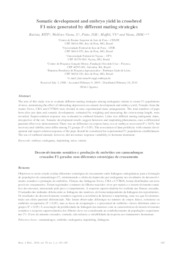Somatic development and embryo yield in crossbred F1 mice generated by different mating strategies.
Somatic development and embryo yield in crossbred F1 mice generated by different mating strategies.
Author(s): BATISTA, R. I. T. P.; WOHLRES-VIANA, S.; PINTO, I. S. B.; MAFFILI, V. V.; VIANA, J. H. M.
Summary: The aim of this study was to evaluate different mating strategies among endogamic strains to create F1 populations of mice, minimising the effect of inbreeding depression on somatic development and embryo yield. Females from the strains Swiss, CBA and C57Bl/6 were divided in nine experimental mate arrangements. The total numbers of pups born alive per dam and somatic development, estimated by weighing and measuring the crown-rump length, were recorded. Superovulation response was evaluated in outbreed females. Litter size differed among endogamic dams, irrespective of the sire. Somatic development results suggest heterosis and imprinting phenomena, once a differential parental effect was demonstrated. There was no difference in corpora lutea, ova or embryos recovered (P > 0.05), but recovery and viability rates differ among F1 groups (P < 0.05). The association of dam prolificity with somatic development and superovulation response of the pups should be considered for experimental F1 populations establishment. The use of outbreed animals, however, did not reduce response variability to hormone treatment.
Publication year: 2010
Types of publication: Journal article
Unit: Embrapa Dairy Cattle
Keywords: Embryo, Endogamy, Imprinting, mice, strains
Observation
Some of Embrapa's publications are published as ePub files. To read them, use or download one of the following free software options to your computer or mobile device. Android: Google Play Books; IOS: iBooks; Windows and Linux: Calibre.
Access other publications
Access the Agricultural Research Database (BDPA) to consult Embrapa's full library collection and records.
Visit Embrapa Bookstore to purchase books and other publications sold by Embrapa.

